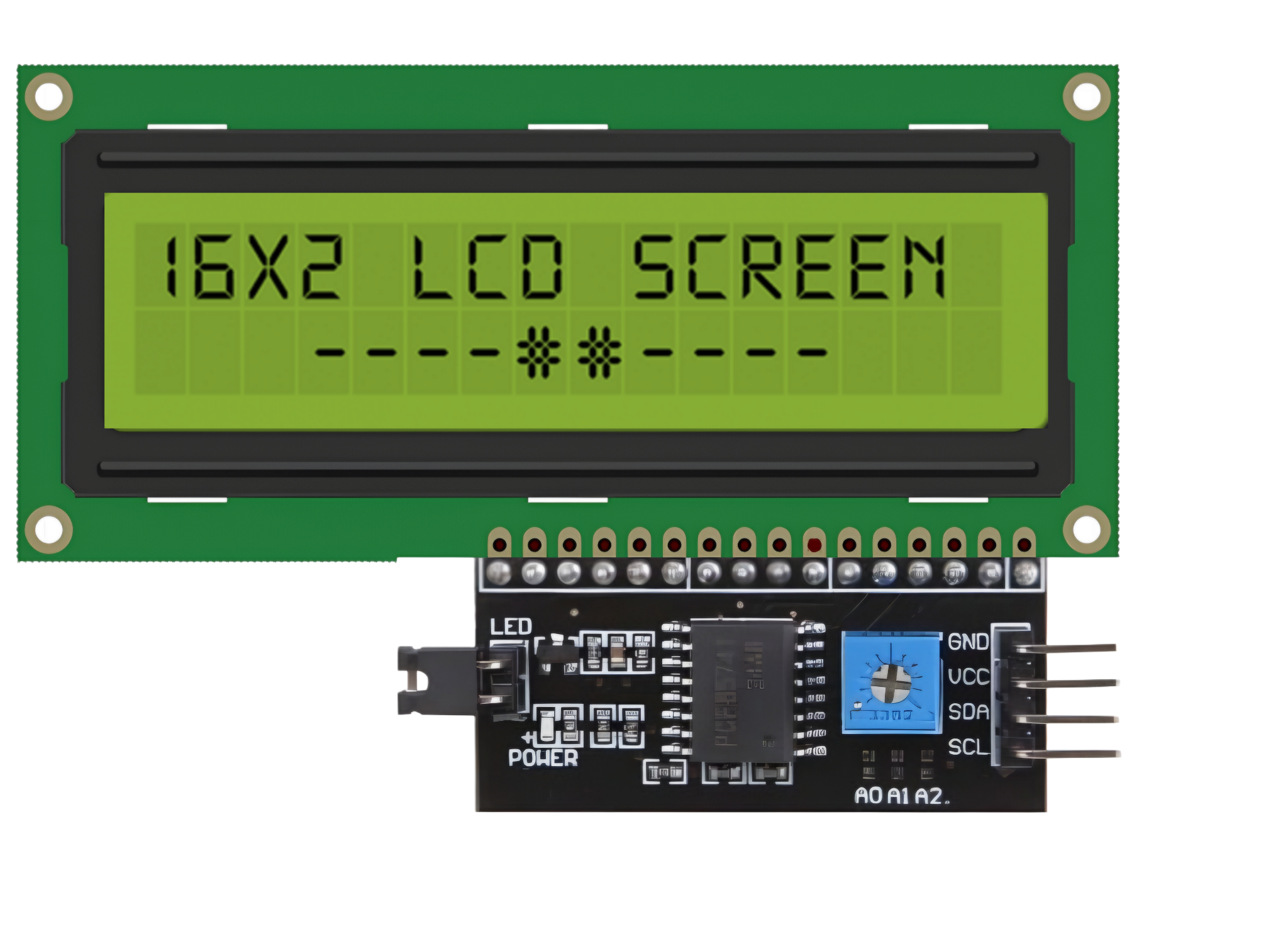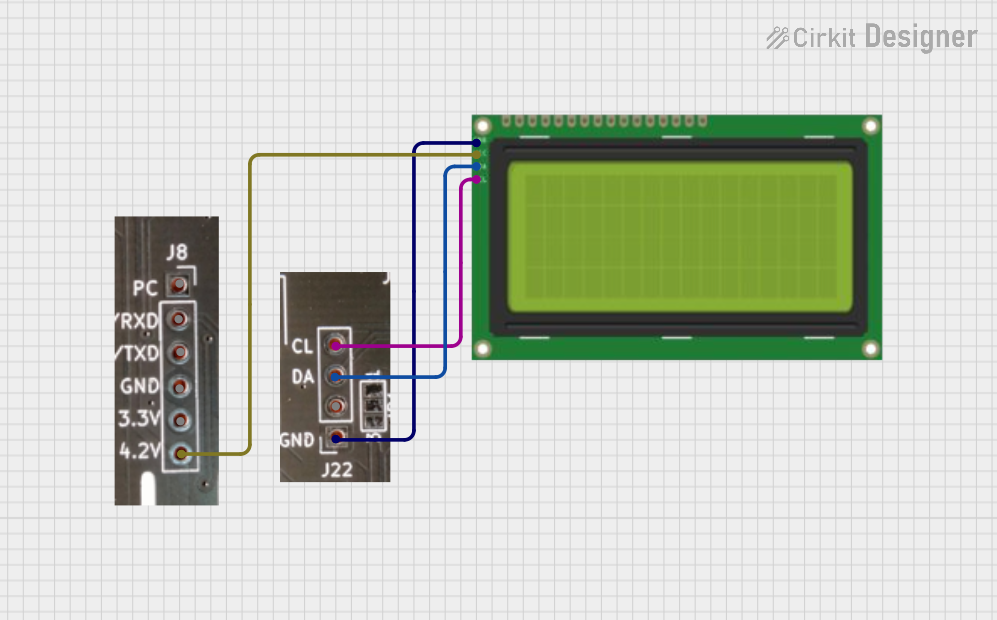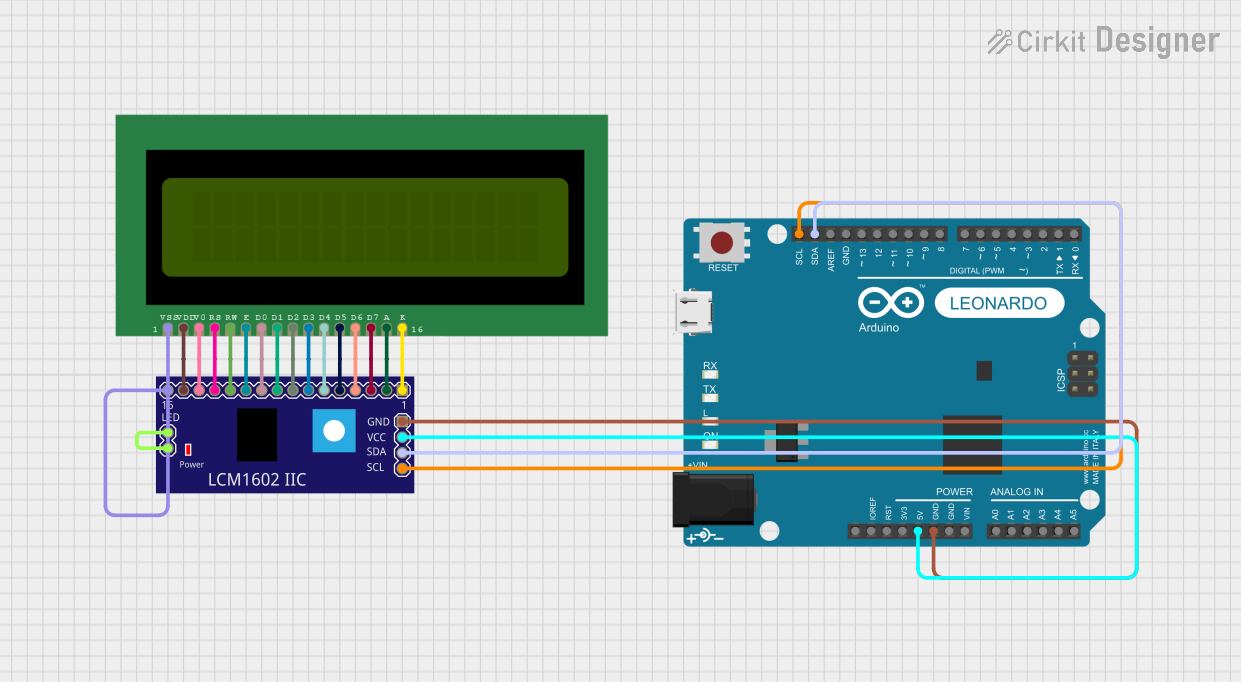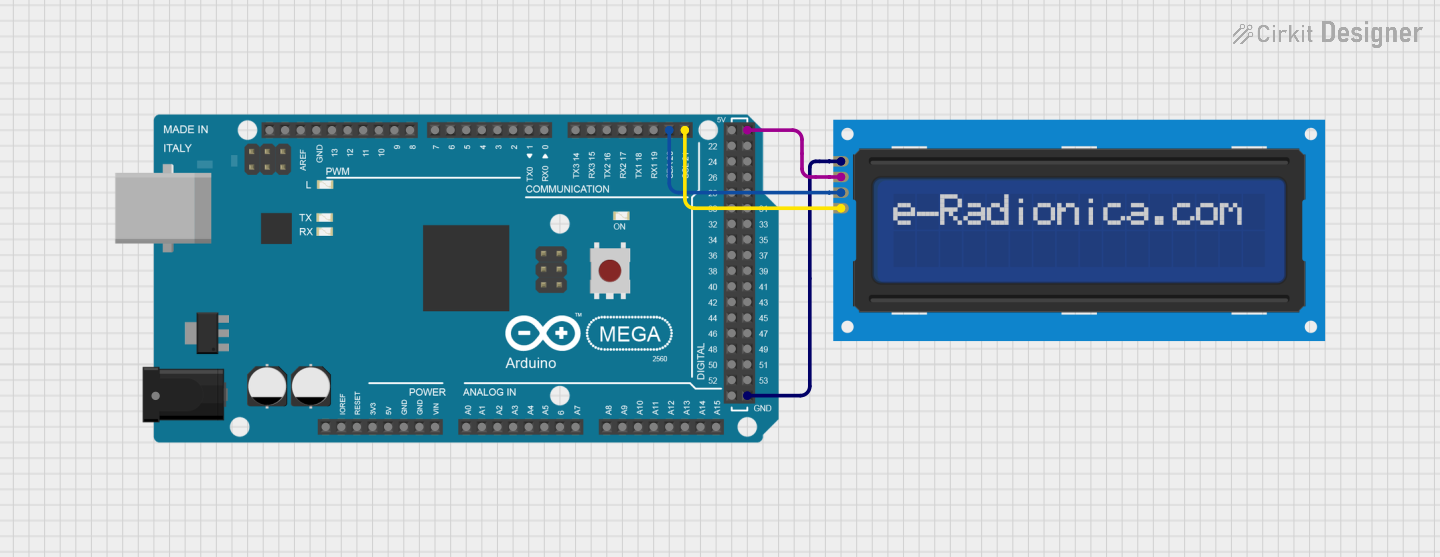
How to Use LCD 16x2 attached i2c: Examples, Pinouts, and Specs

 Design with LCD 16x2 attached i2c in Cirkit Designer
Design with LCD 16x2 attached i2c in Cirkit DesignerIntroduction
The LCD 16x2 with I2C interface is a 16-character by 2-line alphanumeric display module. It features an integrated I2C communication interface, which significantly reduces the number of pins required for connection to a microcontroller. This makes it an ideal choice for projects where pin availability is limited or where simplified wiring is desired.
Explore Projects Built with LCD 16x2 attached i2c

 Open Project in Cirkit Designer
Open Project in Cirkit Designer
 Open Project in Cirkit Designer
Open Project in Cirkit Designer
 Open Project in Cirkit Designer
Open Project in Cirkit Designer
 Open Project in Cirkit Designer
Open Project in Cirkit DesignerExplore Projects Built with LCD 16x2 attached i2c

 Open Project in Cirkit Designer
Open Project in Cirkit Designer
 Open Project in Cirkit Designer
Open Project in Cirkit Designer
 Open Project in Cirkit Designer
Open Project in Cirkit Designer
 Open Project in Cirkit Designer
Open Project in Cirkit DesignerCommon Applications and Use Cases
- Displaying sensor readings (e.g., temperature, humidity, etc.)
- User interfaces for embedded systems
- Menu systems for control panels
- Real-time status updates in IoT projects
- Educational and prototyping purposes
Technical Specifications
Key Technical Details
- Display Type: 16x2 character LCD
- Interface: I2C (Inter-Integrated Circuit)
- I2C Address: Default
0x27(may vary depending on the module; check your specific device) - Operating Voltage: 5V DC
- Backlight: LED with adjustable brightness
- Character Size: 5x8 dot matrix
- Power Consumption: ~2mA (without backlight), ~25mA (with backlight)
- Dimensions: 80mm x 36mm x 12mm (approx.)
Pin Configuration and Descriptions
The I2C interface reduces the number of pins required to just four. Below is the pin configuration:
| Pin Name | Description |
|---|---|
| VCC | Power supply (5V DC) |
| GND | Ground |
| SDA | Serial Data Line for I2C communication |
| SCL | Serial Clock Line for I2C communication |
Usage Instructions
How to Use the Component in a Circuit
Wiring: Connect the LCD 16x2 I2C module to your microcontroller as follows:
VCCto the 5V pin of the microcontroller.GNDto the ground pin of the microcontroller.SDAto the I2C data pin (e.g., A4 on Arduino UNO).SCLto the I2C clock pin (e.g., A5 on Arduino UNO).
Install Required Libraries:
- Use the Arduino IDE and install the
LiquidCrystal_I2Clibrary. To do this:- Go to Sketch > Include Library > Manage Libraries.
- Search for
LiquidCrystal_I2Cand install the library by Frank de Brabander.
- Use the Arduino IDE and install the
Write and Upload Code:
- Use the example code below to display text on the LCD.
Example Code for Arduino UNO
#include <Wire.h> // Include the Wire library for I2C communication
#include <LiquidCrystal_I2C.h> // Include the LiquidCrystal_I2C library
// Initialize the LCD with I2C address 0x27 and 16x2 dimensions
LiquidCrystal_I2C lcd(0x27, 16, 2);
void setup() {
lcd.begin(); // Initialize the LCD
lcd.backlight(); // Turn on the backlight
lcd.setCursor(0, 0); // Set cursor to the first row, first column
lcd.print("Hello, World!"); // Print text on the first row
lcd.setCursor(0, 1); // Set cursor to the second row, first column
lcd.print("I2C LCD Test"); // Print text on the second row
}
void loop() {
// No actions in the loop for this example
}
Important Considerations and Best Practices
- I2C Address: The default I2C address is typically
0x27, but some modules may use0x3For other addresses. Use an I2C scanner sketch to determine the correct address if needed. - Power Supply: Ensure a stable 5V power supply to avoid flickering or malfunction.
- Contrast Adjustment: Most modules have a potentiometer on the back to adjust the display contrast.
- Backlight Control: Use the
lcd.backlight()andlcd.noBacklight()functions to control the backlight programmatically.
Troubleshooting and FAQs
Common Issues and Solutions
No Display or Blank Screen:
- Verify the wiring connections, especially
VCCandGND. - Check the contrast adjustment potentiometer on the back of the module.
- Ensure the correct I2C address is used in the code.
- Verify the wiring connections, especially
Garbage Characters on the Screen:
- Ensure the I2C address matches the module's address.
- Verify that the
LiquidCrystal_I2Clibrary is correctly installed and included.
Backlight Not Working:
- Check the
lcd.backlight()function in the code. - Ensure the module is receiving sufficient power.
- Check the
I2C Address Unknown:
- Use an I2C scanner sketch to detect the module's address. Example:
#include <Wire.h> void setup() { Wire.begin(); Serial.begin(9600); Serial.println("Scanning for I2C devices..."); for (byte address = 1; address < 127; address++) { Wire.beginTransmission(address); if (Wire.endTransmission() == 0) { Serial.print("I2C device found at address 0x"); Serial.println(address, HEX); } } } void loop() { // No actions in the loop }
- Use an I2C scanner sketch to detect the module's address. Example:
FAQs
Can I use this module with 3.3V microcontrollers?
- Most modules are designed for 5V operation. Use a level shifter for compatibility with 3.3V systems.
How do I display custom characters?
- The
LiquidCrystal_I2Clibrary supports custom characters. Refer to the library documentation for details.
- The
Can I connect multiple I2C devices to the same microcontroller?
- Yes, as long as each device has a unique I2C address. Use an I2C multiplexer if address conflicts occur.
By following this documentation, you can effectively integrate and troubleshoot the LCD 16x2 I2C module in your projects.